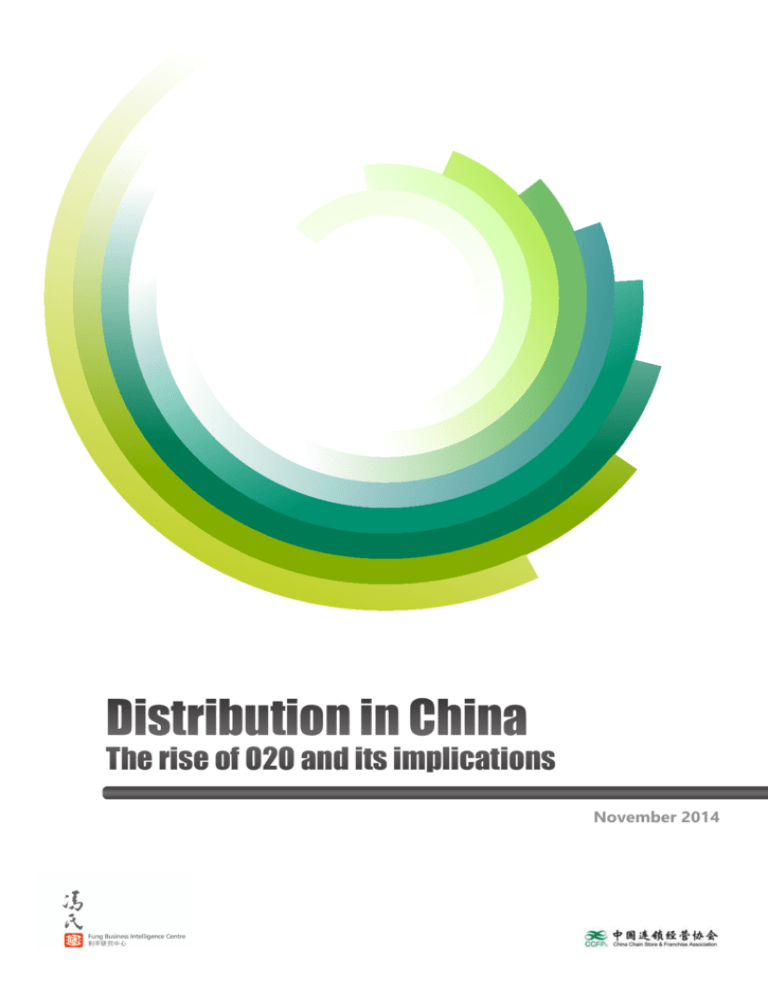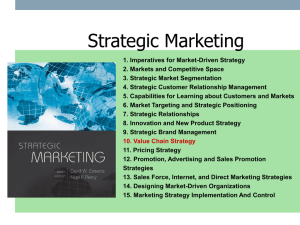
Distribution in China
The rise of O2O and its implications
November 2014
Introduction
2
Distribution in China - The rise of O2O and its implications / November 2014
O
n China’s Singles’ Day, a festival celebrating
being singles in China which has later turned
into the biggest shopping day in the world, a couple
of weeks ago, Alibaba hit another sales record. A
total of 57.1 billion yuan or US$ 9.3 billion of sales
were realised, up by 57.7% year-on-year (yoy) from
almost 280 million online orders. E-commerce is
likely to be the next engine of consumption growth
in China. In fact, the Chinese government has
officially identified e-commence as one of the six
major areas to boost domestic consumption in
a recent State Council meeting. Series of policies
and measures supporting the development of
e-commerce are expected to be launched in the
coming future.
Realising the huge potential of e-commerce,
increasing numbers of traditional bricks-andmortar retailers in China have embarked their
own mobile and social media strategies to lure
more customers. However, most of them have
yet to borne fruits. Meanwhile, capitalising on
the success of the online market, pure-click
companies are evolving from selling only online
to building a physical presence.
Moreover, both bricks-and-mortar retailers and
pure-click companies have started implementing
“O2O” or “online and offline integration” (also
known as omni-channel strategies), aiming at
providing consumers with seamless experience
across multiple marketing and sales channels.
To shed light on the latest developments of
online operations and O2O initiatives, and the
implications for distributors in China, the Fung
Business Intelligence Centre, together with the
China Chain Store and Franchise Association
(CCFA), conducted a survey among traditional
bricks-and-mortar retailers in China earlier
this year. Apart from the survey, face-to-face
interviews with retailers were conducted as well.
In this report, we first provide the background
to the booming e-commerce and the rise of O2O
in China, followed by a summary of the survey
results. Then, we discuss how players along the
supply chain react respectively. We also address
the implications for distributors hoping to survive
and thrive amid the O2O era.
Note: This English publication only summarises
the key takeaways of the Chinese report. For
more details of the Chinese report, please kindly
visit http://www.ccfa.org.cn/portal/cn/view.
jsp?lt=33&id=416944.
3
Background
Booming e-commerce &
the rise of O2O in China
C
hina’s online retail market has registered stunning
growth over recent years, and became the world’s
largest market in 2013. According to iResearch, the
transaction value of China’s online market increased by
59.4% yoy to reach 1.89 trillion yuan in 2013, accounting
for 8.0% of the country’s total retail sales. Total online
sales are expected to reach 5.63 trillion yuan by 2017,
accounting for 15.7% of the total retail sales (see Exhibit 1).
By contrast, proportion of sales of China’s top 100
retail chain operators1 (the Top 100s) to total retail
sales in China dropped from its all time high of 11.2%
in 2007 to 8.6% in 2013. The significant slowing of Top
100 sales was due to the combined impact of changing
consumer behaviour and intensified competition from
1
4
China Chain Store and Franchise Association released its annual list of “the Top 100
Retail Chain Operators in China” in April 2014. The retail chain operators on the list are
mostly bricks-and-mortar retailers. For more details on this year’s annual list of the Top
100 Retail Chain Operators in China, please refer to page 10 of “The Changing Face of
China’s Retail Market” September 2014, Fung Business Intelligence Centre. http://www.
funggroup.com/eng/knowledge/research/china_dis_issue120.pdf
Distribution in China - The rise of O2O and its implications / November 2014
Exhibit 1
Transaction value of online shopping in China,
2010-2017 (estimates)
Source: iResearch
Exhibit 2
online retailers. At the same time, online retailing
is expected to continue its growth momentum
and will likely overtake the Top 100s in terms of
proportion to total retail sales in 2014 or 2015
the latest.
What are the driving forces behind the
e-commerce boom? An expanding Internet
population is a major driving force for the
robust growth of e-commerce. In fact, China
has the world’s largest online population. The
China Internet Network Information Center
(CNNIC) reveals that China’s Internet population
amounted to 632 million in 1H14, with a
penetration rate of 46.9%, while the number of
China’s online shoppers reached 332 million in
1H14 (see Exhibit 2).
Number of online shoppers and online shopping
penetration, 2008-2013
Number of online shoppers (million)
Online shopping penetration rate (%)
350
50%
45%
300
40%
250
35%
30%
200
25%
150
20%
100
15%
10%
50
5%
0
2008
2009
2010
2011
2012
2013
0%
Source: China Internet Network Information Center
5
E-commerce going mobile
The rising popularity of mobile
devices across China over
recent years has also driven the
growth of e-commerce and it
has dramatically altered the way
people shop. As consumers are
accustomed to buying online
via their mobile devices, mobile
commerce (m-commerce) is
becoming a major part of the
e-commerce purchase cycle. The
CNNIC revealed that the number
of m-commerce users amounted
to 205 million in 1H14, up by 42%
from 4Q13, accounting for 32% of
China’s total Internet population
(see Exhibit 3). The popularity
of m-commerce is set to grow
further – iResearch estimates the
total transaction value of mobile
shopping to exceed 3,207 billion
yuan by 2017, up from 274 billion
yuan in 2013.
Exhibit 3
Number of mobile shoppers and online shopping penetration,
December 2013 - June 2014
350
60%
300
50%
250
40%
200
30%
150
100
20%
50
10%
0%
0
December 2013
June 2014
As consumers are becoming
Online shopping penetration (%)
Online shoppers
accustomed to buying online via
their mobile devices, retailers
Mobile shoppers
Mobile shopping penetration (%)
are putting more efforts into
expanding their mobile services.
Source: China Internet Network Information Center
Many have launched mobile apps
to reach out to customers. At the
same time, retailers have also
leveraged the huge user databases of popular social media platforms such as Tencent’s WeChat and Weibo
to promote their products and services.
Increasing numbers of Internet companies have launched mobile payment services over recent years; this
has made the m-commerce process easier. For instance, Tencent has rolled out Tenpay, a mobile payment
services offered through WeChat; banks accounts can be bundled on a WeChat account, facilitating WeChat
users to pay on the go. Alipay, the mobile payment arm of Alibaba has also introduced Alipay Wallet
mobile app that not only facilitates online payments, but also supports offline transaction at points of sales
using barcodes or QR codes.
6
Distribution in China - The rise of O2O and its implications / November 2014
O2O: a focus area for retailers
Consumers are now more discerning and highly connected, and they increasingly seek “shopping
convenience” where they can shop anytime, anywhere and in any way, via a variety of channels. They
also expect multiple methods of payment and various pickup and return options. There is growing
demand for an integrated shopping experience across multiple channels.
In recent times, an increasingly number of retailers are exploring O2O. By embracing different
types of new technologies and investing in multi-channel capabilities, retailers hope to deliver an
impactful and seamless customer experience. Some of the most common ways retailers in China are
experimenting their O2O initiatives include:
2
•
Launching mobile apps and offering location-based marketing
•
Offering mobile payment services in-store
•
Using QR codes to bridge online and offline channels
•
Creating a shared customer database and loyalty programme
•
Supporting “click and collect”; customers can buy online and pick up the online orders
in a physical store
•
Integrating back-end operations and systems such as inventory, warehouses and
logistics management systems
•
Unifying online and offline pricing
“China’s E-commerce Sector – Online Retailing in Transition.” October 2014. Fung Business Intelligence Centre. http://www.funggroup.com/eng/knowledge/research/
china_dis_issue122.pdf
7
Survey results
T
he Fung Business Intelligence Centre, together with
the China Chain Store and Franchise Association,
conducted a survey among traditional bricks-and-mortar
retailers in China earlier this year. A total of 56 valid
samples were collected. About 61% of the surveyed
traditional retailers have opened online shops as of end
2013. Major survey findings are summarized as follows:
8
Distribution in China - The rise of O2O and its implications / November 2014
Online product offerings are not rich enough
As shown in exhibit 4, among the surveyed enterprises who have started online retailing, 66% of them sold
grocery products and 53% offered non-grocery products (excluding communication, consumer electronics
and computer products). In terms of number of stock keeping units (SKUs), over 50% of the online shops
offered less than 3,000 SKUs, presenting a relatively limited range of products (see exhibit 5).
Exhibit 4 Product category offered by the online store
66%
Grocery products
Non-grocery products
excluding communication, consumer
electronics and computer products
41%
Fresh food
Communication, consumer
electronics and computer
products
MISC
Other
products
53%
34%
19%
Exhibit 5 Number of SKUs
offered by the online store
22%
<1,000
31%
1,000-3,000
19%
3%
19%
6%
3,000-5,000
5,000-10,000
10,000-50,000
>50,000
Source: China Chain Store and Franchise Association (CCFA) & Fung Business Intelligence Centre (FBIC)
9
Sales volumes of the online stores are not impressive
Exhibit 6 Online sales volume in 2013
Online sales volume
40%
< 5 millon yuan
16%
5-10 million yuan
16%
10-30 million yuan
16%
30-100 million yuan
6%
6%
100-300 million yuan
> 300 million yuan
About 40% of the retailers recorded online sales of below 5 million yuan
in 2013. Only about 12% of the retailers could sell over 100 million yuan in
2013. And almost 70% reported that the average number of orders per day
is below 500. In terms of proportion of online retailing to total sales, over
80% of the surveyed enterprises said the figure was below 5%. Exhibits 6-8
show more details.
Exhibit 7 Average number of
online orders per day
< 100
100-500
500-1,000
1,000-3,000
3,000-10,000
1-5%
5-10%
10-20%
20-30%
>30%
87%
7%
3%
3%
0%
> 10,000
42%
26%
16%
3%
7%
6%
Exhibit 8 Online sales as a proportion to total retail sales
Source: China Chain Store and Franchise Association (CCFA) & Fung Business Intelligence Centre (FBIC)
10
Distribution in China - The rise of O2O and its implications / November 2014
Modest investment generates unimpressive return
Almost half of the retailers invested less than 5 million yuan in their online operation and over 60% of the retailers
hired less than 30 staff to run their online operation. The relatively modest investment led to unimpressive sales
performance – 63% of the retailers reviewed that the performance of online stores were just fair, with modest
contribution to the total sales of the enterprises. Please see exhibits 9-11 for more details.
Exhibit 9 Capital investment in the online store
49%
30%
<5
millon yuan
5-20
million yuan
15%
20-50
million yuan
0%
6%
50-100
million yuan
>100
million yuan
Exhibit 10 Size of online operation team
36%
26%
13%
10%
6%
< 10
10-30
30-60
3%
60-100
100
-300
6%
300 >500
-500
Investment
Highly significant,
with enormous contribution to total sales
12%
Exhibit 11
Performance of the online store
Quite significant,
with substantial contribution to total sales
Fair,
with modest contribution to total sales
No impact on boosting sales
3%
63%
19%
Don’t know
3%
Source: China Chain Store and Franchise Association (CCFA) &
Fung Business Intelligence Centre (FBIC)
11
Distribution in China - The rise of O2O and its implications / November 2014
Talents shortage is the major challenge for developing e-commerce
When asked about major challenges facing the traditional retailers for developing e-commerce, 78% stated lack
of talents. Logistics facilities not supporting e-commerce (38%) and weakness in developing clear e-commerce
strategies (38%) were also commonly cited (see exhibit 12).
Exhibit 12 Challenges for developing e-commerce
78%
Lack of talents
Logistics facilities does not support
e-commerce business
38%
Weakness in developing clear
e-commerce strategies
38%
36%
Huge capital outlay is required
Existing supply chain does not
support e-commerce business
33%
Online and offline pricing strategies
Lack of mechanism to support
development of e-commerce
MISC
Others
29%
25%
4%
A growing number of traditional retailers are engaging in O2O initiatives
43% of the surveyed traditional retailers have launched different types of O2O initiatives. The remainder stated that
they are willing to give it a try in future. 65% of these retailers launched O2O initiatives on their own. Other enterprises
sought help from outside parties – 17% of them partnered with Tencent while 13% worked with Alibaba (see exhibit 13).
Exhibit 13 Partnership with outside parties
65%
17%
Team up with Tencent
Launched O2O initiatives
on their own
13%
Team up with Alibaba
8%
Team up with JD.com
8%
Team up with Yihaodian
8%
Others
O2O
MISC
12
Source: China Chain Store and Franchise Association (CCFA) & Fung Business Intelligence Centre (FBIC)
How do players along
supply chains respond to
the rise of O2O?
I
n light of the rise of O2O in China and the changes it
has brought about, how do the players along supply
chains respond?
Manufacturers extend to distribution and retail businesses
The stunning growth of e-commerce in China offers manufacturers an additional distribution channel. In the past,
they used to sell only to distributors or retailers. But now, they can sell their products directly to consumers via
either B2B platforms like 1688.com or B2C platforms like Tmall, or build their own online store. Manufacturers now
adopt a new model – branching out from manufacturing into distribution and retailing.
Traditional retailers develop new business models
– embracing O2O initiatives as well as developing merchandise direct sales
It is inevitable that e-commerce will pose a threat to bricks-and-mortar retailers. Indeed, some traditional retailers,
especially the department stores and some specialist retailers such as the consumer electronics specialist retailers,
have seen significant slowdown in sales growth over recent years as a result of the combined impact of intensified
competition from online retailers and changing consumer behaviour. Realising the increasing importance of online
retailing, many traditional retailers have already launched their O2O initiatives. Setting up online stores, launching
mobile apps, engaging in social media and launching mobile payment choices are the mostly observed.
Meanwhile, some department store operators have recognised the drawbacks of the prevailing concessionary model
– low profit margins, poor differentiation of brands and products and low customer loyalty, and tried to develop a
more sustainable one by engaging in merchandise direct sales. They source products directly from suppliers and
generate profits from merchandise mark ups rather than commissions.
13
Distribution in China - The rise of O2O and its implications / November 2014
Product distribution in China
In general, goods have to pass through multiple tiers of distributors before reaching the hands of consumers in China.
There are different parties involved in these supply chains, being agents, distributors, wholesalers and sub-distributors.
Given the complexity of the China market, companies distribute via several different models depending on their needs.
The majority adopt a combination of distribution models. More information on distribution sector in China can be
found at http://www.funggroup.com/eng/knowledge/research/china_dis_issue112.pdf.
Brand owners,
Manufacturers
Brand owners,
Manufacturers
Agents
Distributors,
Wholesalers,
Sub-distributors
Retailers
Consumers
Distributors,
Wholesalers,
Sub-distributors
Retailers
Consumers
Retailers
Consumers
Brand owners,
Manufacturers
Brand owners,
Manufacturers
Consumers
Source: Fung Business Intelligence Centre (FBIC)
Logistics service providers also tap into distribution and retail businesses
Logistics service providers have also started venturing into the retail sector. For instance, SF Express, one of the
largest courier service providers in China, launched its online store, SF Best, in 2012. The online store sells mainly
fresh farm produce and other edible products. SF Express has also engaged in O2O initiatives recently. Orders
placed on SF Best can be delivered to consumers’ preferred address, or collected at SF Express service centers as
well as SF Express community service stores, Heike. Besides picking up online orders from SF Best, customers can
also place online orders with the smart devices available in the Heike stores. Moreover, customers can also enjoy a
wide range of services, such as ATM service, mobile phone credit top up service and bill payment service, at Heike
stores.
Distributors also develop new business models
– supplying to online channels and engaging in retail business
The box above shows how products are distributed from manufacturers to the hands of consumers in China.
Amid the O2O era, upstream, manufacturers sell via online platforms. Downstream, retailers operate online stores
and develop merchandise direct sales. Distributors need to adapt to the changing environment and provide new
service offerings. For instance, some distributors supply products to online stores now. Some even start opening
online stores for their clients (i.e. brand owners) as well.
14
Conclusion
T
he rise of the Internet is an irreversible trend and it
brings about revolutionary changes to the distribution
and retail sector. Everything is now just “a few taps away”.
Manufacturers, retailers, logistics service providers are
all moving with the times and adopting new business
models. Distributors are no exception and should keep the
followings in mind.
15
Maximising client satisfaction
by adopting more diversified distribution models
Consumer buying habits and preferences are changing across all channels. To respond, retailers have
started providing new facilities and service offerings as well as launching O2O initiatives. For example,
some retailers have set up pick up points in the retail shops in affiliated convenience stores for online
order pick up; such new service offerings require adjustments for the back end operation such as
warehouse management and logistics arrangements. Even manufacturers have begun to sell to retailers
or consumers directly. Distributors should adapt to the dynamic market and review their service offerings
to their clients. For instance, supplying products to online stores efficiently is obviously a new type of
service distributors should provide.
Achieving competitive edge
by capitalising on advanced technologies
Technology is such a powerful enabler that it in fact changes the way people shop. Advanced technologies
allow enterprises to open online stores, engage in social media and launch mobile apps. Besides, IT
technologies also act as a powerful tool for data analytics to track consumer behaviour and preferences.
With the big data, distributors can enhance customer service, improve product design and innovation,
target customer segments more effectively as well as better engage with customers. For instance,
distributors can recommend products to the customers precisely when they go online. This not only
brings in more sales, but also strengthens customer loyalty. Distributors should recognise the critical role
of big data and equip themselves with the appropriate hardware, including a bespoke IT system, and a
competent IT team to meet the new service requirements.
Monitoring consumer behaviour and preferences
by embracing smart devices and mobile platforms
Thanks again to the technological advancement, smart devices are becoming mainstream. The mobile
platform is now a highly popular sales and marketing channel. Many consumers shop and settle payment
via smart devices such as smartphones. Moreover, as Chinese consumers engage actively in social media,
it now plays a larger role in supporting consumer purchase decisions. Indeed, many Chinese shoppers
like to visit online blogs, forums, review websites and social networks for reviews and comments before
making purchases. In light of this, distributors should, together with brand owners, develop mobile
strategies, such as developing mobile apps, for marketing and sales purposes.
Boosting further growth
by establishing self-operated online platforms
Instead of merely adapting to changes and new requirements by existing clients, distributors should
consider building their own online distribution platform. With their own online distribution platform,
distributors will be able to open online stores for their existing clients. Meanwhile, distributors could
lure new clients to open online stores at the same platform as well. Yet, setting up a self-operated online
platform is no easy task as it requires huge capital outlay and professional knowledge. Distributors should
consider forming alliances with players along supply chains, including manufacturers, retailers, logistics
service providers, online payment solution providers and IT consultants, to build an online distribution
platform.
16
About the Organizations
The China Chain Store and
Franchise Association
Founded in 1997, the China Chain Store & Franchise
Association (CCFA) is an official representative of the
retailing and franchise industry in China. Currently,
there are 1,000 enterprise members with 200,000
outlets, including domestic and overseas retailers,
franchisers, suppliers, and relevant organizations. The
total sales of China’s “Top 100 retail chain operators”,
which are part of the members of the CCFA,
amounted to about 2.03 trillion yuan in 2013.
CCFA participates in policy making and coordination,
safeguards the interests of industry and members,
provides a series of professional training and industry
information and data for its members and establishes
platforms for exchange and cooperation.
The Fung Group
The Fung Group is a privately held multinational
group of companies headquartered in Hong Kong
whose core businesses are trading, logistics,
distribution and retailing. The Fung Group employs
over 45,000 people across 40 economies worldwide,
generating total revenue of more than US$22.6 billion
in 2013. Fung Holdings (1937) Limited, a privately held
business entity headquartered in Hong Kong, is the
major shareholder of the Fung group of companies.
The Fung Business Intelligence Centre
Contact
Fung Business Intelligence Centre
10/F LiFung Tower
888 Cheung Sha Wan Road
Kowloon, Hong Kong
T: (852) 2300 2470
F: (852) 2635 1598
E: lfdc@lf1937.com
Official WeChat Account: FBIC_2000
The Fung Business Intelligence Centre, through its
unique relationships, collects and analyses market
data on China’s economy, with special reference to
sourcing, supply chains, distribution and retail. It
also produces reports on sourcing and trading in
other Asian countries and has recently expanded
its research services on the global retail industry,
where unprecedented change is being driven by
technological innovation, the advent of multi-sales
channels and greater supply chain efficiency.
Serving as a knowledge bank for the Fung Group,
the Centre also makes its market data and analysis
available to businesses, scholars and governments
around the world. It is an impartial thought leader
on issues shaping the future of manufacturing,
distribution, logistics and retailing in China, and
retailing globally. It regularly provides advice and
consultancy services to internal and external clients.
© Copyright 2014 The Fung Business Intelligence Centre. All rights reserved. The information contained herein is of a general nature and is not intended to address
the circumstances of any particular individual or entity. Though the Fung Business Intelligence Centre endeavours to ensure the information provided in this
publication is accurate and updated, no legal liability can be attached as to the contents hereof. Reproduction or redistribution of this material without prior written
consent of the Fung Business Intelligence Centre is prohibited.








![[DATE] Mary Ziegler Director Division of Regulations, Legislation](http://s3.studylib.net/store/data/007212021_1-b96b03cd98cadfc74a22865c0247494d-300x300.png)
